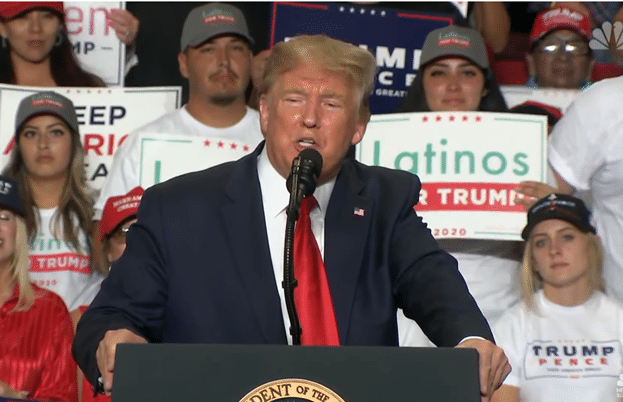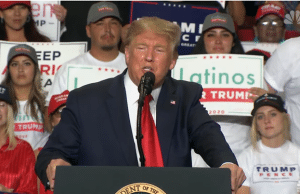
July 9, 2025
Permission to republish original opeds and cartoons granted.
Young, Upwardly Mobile Middle Class Hispanics Could Spell the End for Democrats
| 
|
|
As both parties scramble for the Hispanic vote ahead of the 2026 midterms, which constitutes an estimated 36 million eligible voters nationwide, new polling from a Hispanic advocacy group reveals that younger, educated, upwardly mobile, and bilingual Hispanics could be the largest obstacle for Democrats next fall. A comprehensive survey from UnidosUS of 1,002 Hispanic Americans found that the primary concerns Hispanics face are issues the GOP is seen as better equipped to handle, such as the economy and jobs, inflation, and immigration. According to the UnidosUS survey, higher-income Hispanics hold a substantially more favorable view of Republicans and Trump than lower-income Hispanics. 51 percent of Hispanics with income exceeding $100K hold a positive view of the Congressional Republicans — and 48 percent hold a positive view of President Trump. Among middle-income Hispanics, 38 percent hold a favorable view of Congressional Republicans, and 40 percent hold a favorable view of President Trump. However, among Hispanics earning less than $39K annually, 29 percent hold a favorable view of Congressional Republicans and 33 percent hold a favorable of President Trump. This translates to a 13-point gap in favorability for Congressional Republicans between middle-income and higher-income Hispanics, and a 22-point gap in favorability between lower-income and higher-income Hispanics. Education also plays a role, with Hispanic college graduates holding a more favorable view of Republicans. 46 percent of Hispanic college graduates hold a favorable view of Congressional Republicans. However, 31 percent of Hispanics with some college hold a favorable view of Republicans, and 32 percent of Hispanics with a high school diploma or less hold a favorable view of Congressional Republicans. Another key factor is age. According to the survey, there is a wide bridge between how older Hispanics feel about Congressional Republicans compared to how younger Hispanics feel. Congressional Republicans enjoy their highest favorability among Hispanics in the young professional cohort. |
Baseline Spending Set To Increase $3.38 Trillion By 2034, 56.8 Percent Social Security And Medicare Alone As Baby Boomers Permanently Retire
| 
|
|
Federal spending outlays will increase a whopping $3.38 trillion from their 2024 level of $6.87 trillion to $10.2 trillion by 2034, according to the White House Office of Management and Budget (OMB). It is very easy to see where the cost drivers of the budget and therefore the deficit are — posing a challenge for professional handwringers in Congress who profess they wish to eliminate the deficit or balance the budget. They’re not really serious. Social Security will increase from $1.45 trillion to $2.43 trillion, a $980 billion jump, 28.99 percent of the $3.38 trillion increase, as 1.3 million Americans turn 65 every single year. Medicare similarly will increase from $839 billion to $1.76 trillion, an $927 billion increase, or 27.9 percent of the increased spending. Medicaid will increase from $567 billion to $996 billion, a $429 billion increase, or 12.6 percent of the increased spending. Other mandatory spending, including items like food stamps, federal financial aid for education and so forth will increase from $1 trillion to $1.291 trillion, a $291 billion increase, or 8.6 percent of the increased spending. Net interest owed on the debt will increase from $889 billion to $1.57 trillion, a $612 billion increase, or 20.1 percent of the increased spending. Defense spending will increase from $884 billion to $1.07 trillion, a $218 billion jump, and just 6.4 percent of the increased spending in the baseline. And non-defense spending will increase from $1 trillion to $1.13 trillion, a $171 billion increase, and just 5 percent of the increased spending. So, right off the bat, 56.8 percent of all the increased spending is Social Security and Medicare. Add Medicaid to mix — why not since seniors use that too? — and you wind up with 69 percent of the increased spending is just from those three programs. Does anyone seriously think Congress will cut benefits for seniors? |
Young, Upwardly Mobile Middle Class Hispanics Could Spell the End for Democrats

By Manzanita Miller
Republicans have made significant inroads with Hispanic voters in recent elections, with President Donald Trump earning the greatest share of the Hispanic vote for any modern Republican President in 2024 and House Republicans gaining nine points last fall compared to 2020.
As both parties scramble for the Hispanic vote ahead of the 2026 midterms, which constitutes an estimated 36 million eligible voters nationwide, new polling from a Hispanic advocacy group reveals that younger, educated, upwardly mobile, and bilingual Hispanics could be the largest obstacle for Democrats next fall.
A comprehensive survey from UnidosUS of 1,002 Hispanic Americans found that the primary concerns Hispanics face are issues the GOP is seen as better equipped to handle, such as the economy and jobs, inflation, and immigration.
The survey found that younger, upwardly mobile Hispanic voters — those with a college degree and those in the middle to upper-middle income brackets — are the most receptive to Congressional Republicans and hold the most favorable view of President Donald Trump.
To some, this could be seen as counter intuitive. Among white voters, non-college Americans played a significant role in President Trump’s victory. Among Hispanics, education and income (up to a point) drive voters toward the GOP. The most likely explanation is the GOP’s focus on economic issues, commitment to lowering taxes for the middle class and business owners, emphasis on reducing crime, and more conservative approach to social and gender issues.
According to the UnidosUS survey, higher-income Hispanics hold a substantially more favorable view of Republicans and Trump than lower-income Hispanics. 51 percent of Hispanics with income exceeding $100K hold a positive view of the Congressional Republicans — and 48 percent hold a positive view of President Trump. Among middle-income Hispanics, 38 percent hold a favorable view of Congressional Republicans, and 40 percent hold a favorable view of President Trump.
However, among Hispanics earning less than $39K annually, 29 percent hold a favorable view of Congressional Republicans and 33 percent hold a favorable of President Trump. This translates to a 13-point gap in favorability for Congressional Republicans between middle-income and higher-income Hispanics, and a 22-point gap in favorability between lower-income and higher-income Hispanics.
Education also plays a role, with Hispanic college graduates holding a more favorable view of Republicans. 46 percent of Hispanic college graduates hold a favorable view of Congressional Republicans. However, 31 percent of Hispanics with some college hold a favorable view of Republicans, and 32 percent of Hispanics with a high school diploma or less hold a favorable view of Congressional Republicans.
Another key factor is age. According to the survey, there is a wide bridge between how older Hispanics feel about Congressional Republicans compared to how younger Hispanics feel.
Congressional Republicans enjoy their highest favorability among Hispanics in the young professional cohort — Millennial voters between 30-39. 50 percent of Millennial Hispanics hold a favorable view of Congressional Republicans according to the survey.
In the generation below Millennials, Gen Z voters 18-29, a sizeable portion also hold a favorable view of Congressional Republicans. 43 percent of Gen Z Hispanics hold a positive view of Republicans. As for Gen X, 39 percent of Hispanics in the 40-59 age cohort hold a favorable view of the GOP. Those numbers shift substantially for Hispanics over age 60, with just 17 percent of Hispanics over age 60 saying they have a positive view of the GOP.
This translates to a 26-point gap in favorability for Congressional Republicans between Gen Z Hispanics and Hispanics over age 60, and a 33-point gap in favorability between Millennial Hispanics and Hispanics over age 60. These differences highlight the importance of generational experiences at shaping perceptions of the political landscape, and illustrate that younger upwardly mobile Hispanics are more open to conservative solutions than older generations or those earning less.
Interestingly, bilingual Hispanics, more so than those who do not speak Spanish or those who speak only Spanish, are the most open to conservatives. 45 percent of bilingual Hispanics hold a favorable view of the GOP, and 34 percent of Spanish-only Hispanics hold a favorable view of the GOP. Among English-only Hispanics, 27 percent hold a favorable view of Republicans.
These findings have sizeable implications for the 2026 midterm elections and beyond. Democrats are scrambling to forward a cohesive message to reel in Hispanics and young people after their catastrophic losses in 2024, while conservatives are hoping to maintain the momentum they gathered last November.
Both parties will be vying for the Hispanic vote, which is estimated at over 36 million eligible voters, or 14.7% of the electorate. Gen Z and Millennial voters are predicted to become increasingly influential in elections as well, representing half of the eligible voter electorate by 2026 according to U.S. Census estimates.
President Trump lost Hispanics nationwide by just four percentage points in 2024 after losing them by 33 points to Joe Biden in 2020, marking a significant turning point for the future of the country. Trump also won a greater share of young voters than any Republican in recent history. He lost the youth vote by just 11 points, after losing it by 24 points in 2020.
Congressional Republicans have a significant opportunity in the 2026 midterm cycle and in following elections to make the case to young, upwardly mobile Hispanics that they can offer stronger solutions than Democrats can. This includes a commitment to reducing taxes for the middle-class — something President Trump and Republicans in Congress championed last week in the passage of the One Big Beautiful Bill Act — and a commitment to reducing crime and bringing jobs back to American shores. Hispanics under age 60 — particularly those with college degrees in the young professional cohort and those who are bilingual — are some of the most open to conservative messaging.
Manzanita Miller is the senior political analyst at Americans for Limited Government Foundation.
To view online: https://dailytorch.com/2025/07/young-upwardly-mobile-middle-class-hispanics-could-spell-the-end-for-democrats/
Cartoon: Old Bag Of Tricks
By A.F. Branco

Click here for a higher level resolution version.
To view online: https://dailytorch.com/2025/07/cartoon-old-bag-of-tricks/
Baseline Spending Set To Increase $3.38 Trillion By 2034, 56.8 Percent Social Security And Medicare Alone As Baby Boomers Permanently Retire

By Robert Romano
Federal spending outlays will increase a whopping $3.38 trillion from their 2024 level of $6.87 trillion to $10.2 trillion by 2034, according to former President Joe Biden’s last budget submitted to the White House Office of Management and Budget (OMB).
The estimates are a year old, and we still await President Donald Trump’s first full budget that will adjust the baseline, hopefully taking into account the impacts of the One Big Beautiful Bill Act, but it is still instructive about the dire fiscal trajectory the American people find themselves on.
By this metric, it is very easy to see where the cost drivers of the budget and therefore the deficit are — posing a challenge for professional handwringers in Congress who profess they wish to eliminate the deficit or balance the budget. They’re not really serious.
Social Security will increase from $1.45 trillion to $2.43 trillion, a $980 billion jump, 28.99 percent of the $3.38 trillion increase, as 1.3 million Americans turn 65 every single year.
Medicare similarly will increase from $839 billion to $1.76 trillion, an $927 billion increase, or 27.9 percent of the increased spending.
Medicaid will increase from $567 billion to $996 billion, a $429 billion increase, or 12.6 percent of the increased spending. It is worth noting that this program too has a senior citizen cost driver included, as many seniors might require nursing homes or home attendants that Medicaid covers when their assets are all gone.
Other mandatory spending, including items like food stamps, federal financial aid for education and so forth will increase from $1 trillion to $1.291 trillion, a $291 billion increase, or 8.6 percent of the increased spending.
Net interest owed on the debt will increase from $889 billion to $1.57 trillion, a $612 billion increase, or 20.1 percent of the increased spending.
That’s all the mandatory spending that occurs because eligibility for programs like Social Security, Medicare and Medicaid are written directly into law. To change those laws requires 60 votes in the Senate usually under traditional filibuster rules, which would require a bipartisan consensus.
Then there’s the so-called discretionary spending Congress votes on every year, which is making up a smaller and smaller portion of overall spending, making it difficult to eke any savings from there.
There, defense spending will increase from $884 billion to $1.07 trillion, a $218 billion jump, and just 6.4 percent of the increased spending in the baseline.
And non-defense spending will increase from $1 trillion to $1.13 trillion, a $171 billion increase, and just 5 percent of the increased spending.
So, right off the bat, 56.8 percent of all the increased spending is Social Security and Medicare. Add Medicaid to mix — why not since seniors use that too? — and you wind up with 69 percent of the increased spending is just from those three programs.
Conservatively, OMB estimates the national debt will rise to $52 trillion by 2034. But the truth is the debt has grown on average 8 percent a year since 1980 once wars and recessions are factored in. Another recession here, a war there, and the baseline debt will continue its nearly doubling trajectory it has been on the past several decades, surpassing perhaps $76 trillion by 2035 and $100 trillion not too long after that. By then, the debt to GDP ratio will be well north of 200 percent.
And yet there’s very little that is being done about it currently. Because there is no cure for aging.
Does anyone seriously think that either a bipartisan consensus to cut benefits would ever emerge? It’s a fantasy. Currently there are 61.8 million seniors. There’s also another 41.1 million 55-to 64 year olds will similarly be added to the Social Security and Medicare rolls by 2035, while many current beneficiaries sadly pass away.
And yet on the current trajectory, both the Social Security and Medicare trust funds will be exhausted by 2033 according to the trustees, at which point there might only be enough revenue to pay 80 percent of benefits. At that point: Will Congress A) Let the cuts happen or B) Just borrow the money from the general fund?
Certainly there are other structural reforms that should be considered. For example, the federal government owns about $7.2 trillion of non-marketable treasuries. Could the government get a better rate of return by investing in the economy instead?
And there’s our fertility deficit, the true reason why we’re going broke, since 1960 the number of babies per woman has plummeted from 3.6 to 1.6, accounting for millions of potential taxpayers who were never born. In the meantime, more than two out of three women today are going to college, delaying marriage and child rearing. It’s a vicious cycle.
Apparently, the nation would rather the country goes broke than have an uncomfortable conversation with single women. But you never know, there could be additional financial incentives provided to foster a baby boom, but it would have to compete with the more than $60,000 subsidy that comes up front for college educations, not to mention the higher incomes and lower unemployment that come from women possessing degrees. It won’t be cheap.
As for the current drivers of the debt, Social Security, Medicare and Medicaid, suffice to say, there will be overwhelming political pressure to keep benefits as they are, especially since seniors paid for it. The alternative is likely a political buzzsaw that many fools, including Elon Musk’s newly minted America Party, will insist it is safe to walk under. Good luck with that.
Robert Romano is the Executive Director of Americans for Limited Government Foundation.
To view online: https://dailytorch.com/2025/07/baseline-spending-set-to-increase-3-38-trillion-by-2034-56-8-percent-social-security-and-medicare-alone-as-baby-boomers-permanently-retire/
